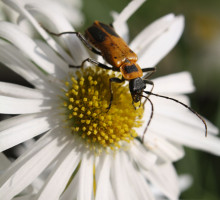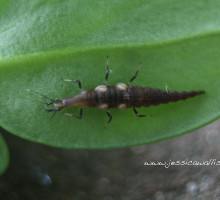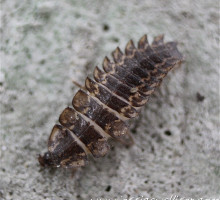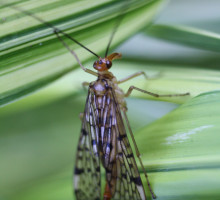
Soldier beetles, like this common Pennsylvania leatherwing, are an ubiquitous sight in my summer garden. There are some 470 different species of soldier beetles in North America and most are considered beneficial. As adults, all species have soft, leathery wings, fly well, and serve to pollinate various flowering plants. Larval soldier beetles live in leaf litter and under rocks, logs, and debris. Larvae feed primarily at night and are fast movers with large, grasping jaws that capture and consume insect eggs and prey, including grasshopper eggs, caterpillars, aphids, mealybugs and many others. Adults consume nectar, with many species also eating aphids and other insects. Both adult and larval soldier beetles can exude foul defensive chemicals to aid in their protection from other predators. In the western U.S., the brown leatherwing is a very common species.

This crazy-looking creature is the larva of a brown lacewing (Micromus species). I found it hanging out on a lily leaf in my garden. Lacewing larvae use their curved mandibles to capture and consume soft-bodied insects like aphids, mealybugs, young caterpillars, beetle larvae, mites, and others. When mature, brown lacewings look much like their green cousins only slightly smaller and with brown coloration.

Fireflies are found on every continent except Antarctica, and there are about 150 different species of fireflies in North America. They are members of the Lampyridae family, and I found this beautiful larva on a driveway near a wetland in eastern Pennsylvania. Fireflies, also commonly called lightning bugs, use their bioluminescent abdomens to attract mates. The pattern of flashes is unique to each species, as is the color of their glow. Males fly around flashing a particular pattern in hopes of finding a female of the same species. He signals first then she signals her response, often from a low perch. Flash pattern charts can be used to distinguish many common species based on the number and duration of their flashes. In the eastern U.S., fireflies are a common summer sight, and while not all species glow as adults, they all do as larvae. Sometimes called glowworms in other parts of the world, larval fireflies, like this one, emit a steady, dull glow from their abdomens. Adult fireflies eat mostly pollen and nectar, though some species eat nothing at all. Female fireflies lay eggs in the ground (though a few tropical species lay eggs in trees). Favored egg laying sites include moist places near ponds and streams and in leaf litter. Larval fireflies live under or on the ground and serve as generalist predators, savoring slugs, snails, worms and other

This beautiful creature is a scorpionfly in the genus Panorpa. I found her in my shade garden clinging to the golden grass. Scorpionflies are named as such because the males have an enlarged abdomen that curls upwards in a scorpion-like fashion. At the tip of the abdomen are two prongs used for mating. Though they may look scary, scorpionflies are incapable of stinging or biting. The elongated, snout-like mouthpart of the female in this picture is a distinctive feature of all scorpionflies. These insects are primarily scavengers, consuming dead or injured insects as well as occasionally preying on healthy ones and eating pollen and nectar. There are about 550 species of scorpionflies, and they are found across the U.S., though they are more common in the south. This is the first one I have ever found in my Pennsylvania garden